Women of desire: female nudes in Venice
Women in peril
During his long career, Titian would work on representations of classical myths in which women found themselves in danger, such as Lucretia being raped by Tarquin or Andromeda given over to the monster. He reenacts the scene of the rape of Lucretia through a stark, palpable depiction, in which the viewer is made to participate.
Unlike Titian, Tintoretto never relied on a classical text but rather on a more personal vision. In his representation of the rape of Lucretia the scene is one of violence—everything seems to crumble beneath the man’s onslaught as he tears away Lucretia’s last remaining garments in her precarious situation, body hurled forward.
For Veronese, timing was all-important. In the Lucretia drama he chooses to depict not the instant of the rape, as do Titian and Tintoretto, but the moment just prior to the young woman’s suicide. In Perseus and Andromeda, the woman is already aware of her salvation. Elegance of line and harmony of color soften the drama.
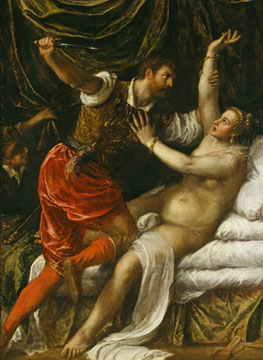 Learn more+
Titian
, Tarquin and Lucretia
Learn more+
Titian
, Tarquin and Lucretia
Cambridge (UK), loaned by The Syndics of the Fitzwilliam Museum
(Inv 914)
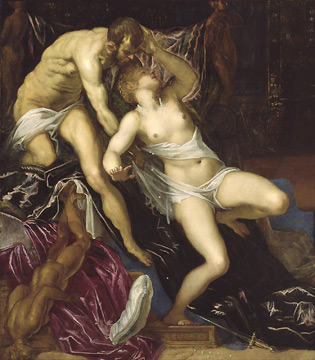 Learn more+
Tintoretto
, Tarquin and Lucretia
Learn more+
Tintoretto
, Tarquin and Lucretia
Chicago, The Art Institute of Chicago
(1949-203)
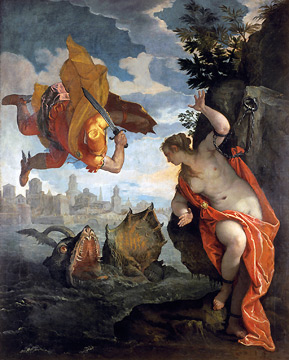 Learn more+
Veronese
, Perseus and Andromeda
Learn more+
Veronese
, Perseus and Andromeda
Rennes, Musée des Beaux-arts
(Inv. 1801.1.1)
Close x
Titian, Tarquin and Lucretia
Cambridge, loaned by The Syndics of the Fitzwilliam Museum
(Inv 914)
Titian accentuates the scene's brutal nature—propped up slightly on cushions, Lucretia struggles against her opponent who thrusts forward between her legs, brandishing his cutlass, ready to strike. The paint applied in thick layers gives the surfaces a tactile impression, thereby reinforcing the scene's violent import.
© Cambridge (UK), Fitzwilliam Museum, University of Cambridge

Click on the picture to zoom: Tarquin and Lucretia (new window)
Close x
Tintoretto, Tarquin and Lucretia
Chicago, The Art Institute of Chicago
(1949-203)
Whereas Titian approached the scene with stark violence, Tintoretto emphasizes its tragic nature through the twisted bodily interplay of the two figures. The painting's dating is open to debate—once considered an early work, it is now ascribed to between 1578 and 1580.
© The Art Institute of Chicago

Click on the picture to zoom: Tarquin and Lucretia (new window)
Close x
Veronese, Perseus and Andromeda
Rennes, Musée des Beaux-arts
(Inv. 1801.1.1)
Veronese took his inspiration from one of Titian's compositions on the same subject, painted for Philip II. Yet where Titian had conveyed the dramatic intensity of the predicament of a terror-stricken Andromeda as the monster draws nearer, Veronese in his elegance affords a hint of a happy ending. Acid tones of orange play alongside the blues of sky and sea, and the rock encircles the woman's body like the setting for a jewel. Perseus plunges toward the beast in a twirling foreshortened view, while the graceful Andromeda confidently awaits the outcome of the battle.
© MBA, Rennes, Dist RMN / Adélaïde Beaudoin

Click on the picture to zoom: Perseus and Andromeda (new window)
Women of desire: female nudes in Venice
Women on offer
In the sixteenth century, Venice was famous for its freethinking, but erotic images were prohibited in public; Titian’s prestigious nudes were therefore reserved for a closed circle of (often foreign) patrons. Titian’s profane nudes are imbued with great sensuality, even if they are based upon mythological themes and are in keeping with the codes of representation. While being freely inspired by Ovid’s Metamorphoses, the pictorial program of the poesie (mythological scenes) painted for Philip II corresponds to a dialectic of love—requited or rejected, happy or tragic—and also allowed Titian to answer to the pre-eminence of painting over sculpture.
Neither Veronese, Tintoretto, nor indeed any other of his youthful “rivals” would manage to equal Titian. Veronese treated profane themes in a more classical, more sculptural vein—a style of great chromatic richness but much less sensual. Tintoretto abandoned nudes offered to delight the viewer’s gaze in favor of dramatic compositions full of movement. His rare representations of female nudes contain few sensual poetic elements.
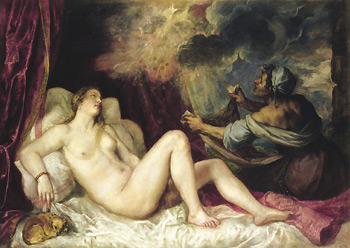 Learn more+
Titian
, Danaë
Learn more+
Titian
, Danaë
Madrid, Museo del Prado
(P00425)
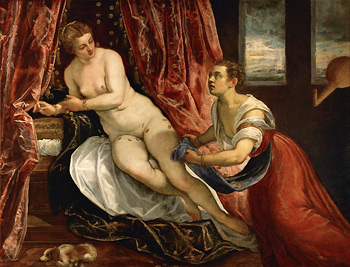 Learn more+
Tintoretto
, Danaë
Learn more+
Tintoretto
, Danaë
Lyon, Musée des Beaux-arts
(inv. A 91 or Inv 2571)
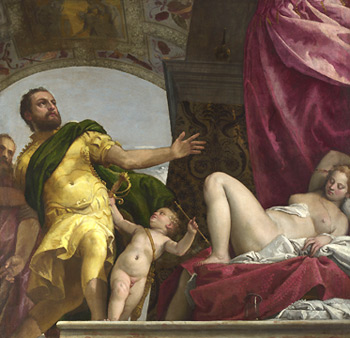 Learn more+
Veronese
, Allegory of Love: Respect
Learn more+
Veronese
, Allegory of Love: Respect
London, The National Gallery
(NG 1325)
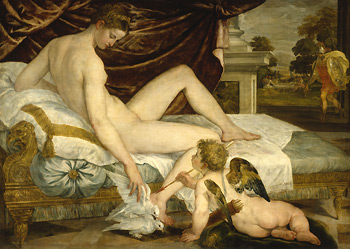 Learn more+
Sustris
, Venus and Cupid
Learn more+
Sustris
, Venus and Cupid
Paris, Musée du Louvre
(Inv. 1978)
Close x
Titian, Danaë
Madrid, Museo del Prado
(P00425)
In his poesie executed for Philip II, Titian went back to the Danaë theme that he had worked on ten years previously. The old maidservant, a kind of go-between, has replaced the small cupid beside this Danaë, in what is now an embodiment of erotic love. The vibrant, broad brushstrokes throb through the young woman's body poised with excitement.
© Museo Nacional del Prado, Madrid

Click on the picture to zoom: Danaë (new window)
Close x
Tintoretto, Danaë
Lyon, Musée des Beaux-arts
(inv. A 91 or Inv 2571)
In this caricature of Titian's erotic scene, Tintoretto has painted a grasping prostitute who ensures that her maidservant is indeed reaping in all of the gold pieces, even if the few coins placed around the woman's genitals are a clear indication that we are in the presence of a Danaë, impregnated by Jupiter in the form of a shower of gold.
© Erich Lessing, Vienna

Click on the picture to zoom: Danaë (new window)
Close x
Veronese, Allegory of Love: Respect
London, The National Gallery
(NG 1325)
This is the third painting in a series of four allegorical compositions on the various aspects of love. The marked foreshortening attests that it was intended for a ceiling. Countering the bare, languid body of the young woman is the man's fully-clothed, dynamic physique; between them a Cupid is gaily trying to grasp the man's sword.
© The National Gallery, londres, Dist. RMN / National Gallery Photographic Department

Click on the picture to zoom: Allegory of Love: Respect (new window)
Close x
Sustris, Venus and Cupid
Paris, Musée du Louvre
(Inv. 1978)
The Dutch painter Sustris spent the majority of his career in Italy—in Venice in particular alongside Titian. In this painting, Venus is stroking some doves (her attributes) in the presence of her son Cupid as she awaits Mars (in the background, right) who is on his way to join her. In 1548 and 1550, Sustris accompanied his master Titian to Augsburg, where he painted this mythological work of sophisticated mannerism, probably for the Fugger family.
© RMN / R. G. Ojéda

Click on the picture to zoom: Venus and Cupid (new window)
Women of desire: female nudes in Venice
Female subjects as decorative elements
While we do not know for sure whether they are decorative elements from wedding chests, dressers, or wall panels, there exist a large number of small rectangular or oblong panels generally depicting scenes from mythology, antiquity, or the Bible in which female subjects are portrayed with great sensuality.
Probably commissioned, these panels appear to have been painted in the early years of artists such as Schiavone, Tintoretto, Veronese, and Sustris, sometimes brought together to work on the same décor, just as each was finding his own voice. Such works are evidence of great sophistication in ornament.
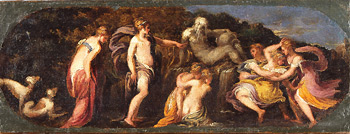 Learn more+
Schiavone
, Diana and Callisto
Learn more+
Schiavone
, Diana and Callisto
Amiens, Musée de Picardie
(MPLav1894-241)
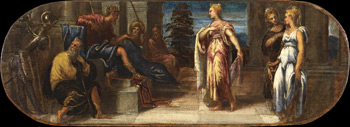 Learn more+
Tintoretto
, Solomon and the Queen of Sheba
Learn more+
Tintoretto
, Solomon and the Queen of Sheba
London, Courtauld Institute of Art Gallery
(P1978.PG457)
Close x
Schiavone, Diana and Callisto
Amiens, Musée de Picardie
(MPLav1894-241)
With his elegant and spirited brushwork, Schiavone is depicting here one of the episodes in the life of Callisto, when Diana discovers that the nymph is pregnant, seduced by Jupiter; the goddess punishes Callisto by changing her into a she-bear.
© Musée de Picardie / Marc Jeanneteau, Amiens

Click on the picture to zoom: Diana and Callisto (new window)
Close x
Tintoretto, Solomon and the Queen of Sheba
London, Courtauld Institute of Art Gallery
(P1978.PG457)
This youthful work of Tintoretto's, with its blend of solemnity and intimacy, is influenced by Schiavone and Tuscan mannerism. It was probably painted as a retort to the great Venetian building projects of decorative art in the 1540s.
© Courtauld Institute of Art Gallery, London

Click on the picture to zoom: Solomon and the Queen of Sheba (new window)



















